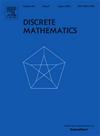Subchromatic numbers of powers of graphs with excluded minors
IF 0.7
3区 数学
Q2 MATHEMATICS
引用次数: 0
Abstract
A k-subcolouring of a graph G is a function such that the set of vertices coloured i induce a disjoint union of cliques. The subchromatic number, , is the minimum k such that G admits a k-subcolouring. Nešetřil, Ossona de Mendez, Pilipczuk, and Zhu (2020), recently raised the problem of finding tight upper bounds for when G is planar. We show that when G is planar, improving their bound of 135. We give even better bounds when the planar graph G has larger girth. Moreover, we show that , improving the previous bound of 364. For these we adapt some recent techniques of Almulhim and Kierstead (2022), while also extending the decompositions of triangulated planar graphs of Van den Heuvel, Ossona de Mendez, Quiroz, Rabinovich and Siebertz (2017), to planar graphs of arbitrary girth. Note that these decompositions are the precursors of the graph product structure theorem of planar graphs.
We give improved bounds for for all , whenever G has bounded treewidth, bounded simple treewidth, bounded genus, or excludes a clique or biclique as a minor. For this we introduce a family of parameters which form a gradation between the strong and the weak colouring numbers. We give upper bounds for these parameters for graphs coming from such classes.
Finally, we give a 2-approximation algorithm for the subchromatic number of graphs having a layering in which each layer has bounded cliquewidth and this layering is computable in polynomial time (like the class of all powers of planar graphs, for fixed d). This algorithm works even if the power p and the graph G is unknown.
求助全文
约1分钟内获得全文
求助全文
来源期刊

Discrete Mathematics
数学-数学
CiteScore
1.50
自引率
12.50%
发文量
424
审稿时长
6 months
期刊介绍:
Discrete Mathematics provides a common forum for significant research in many areas of discrete mathematics and combinatorics. Among the fields covered by Discrete Mathematics are graph and hypergraph theory, enumeration, coding theory, block designs, the combinatorics of partially ordered sets, extremal set theory, matroid theory, algebraic combinatorics, discrete geometry, matrices, and discrete probability theory.
Items in the journal include research articles (Contributions or Notes, depending on length) and survey/expository articles (Perspectives). Efforts are made to process the submission of Notes (short articles) quickly. The Perspectives section features expository articles accessible to a broad audience that cast new light or present unifying points of view on well-known or insufficiently-known topics.
 求助内容:
求助内容: 应助结果提醒方式:
应助结果提醒方式:


